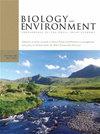Differences in dry matter content between forage varieties of Lolium perenne L.
IF 0.6
4区 环境科学与生态学
Q4 ENVIRONMENTAL SCIENCES
Biology and Environment-Proceedings of the Royal Irish Academy
Pub Date : 2022-01-01
DOI:10.3318/bioe.2019.11
引用次数: 1
Abstract
Abstract:This study mined an existing database comprising 14 years (2002-15) of perennial ryegrass (Lolium perenne L., PRG) variety trials under a 9-cut simulated grazing management. The dry matter content (DM%) values of a total of 246 different varieties in 617 variety x year combinations were compared between ploidies (diploid and tetraploid), maturity groups (early, intermediate and late) and between individual varieties of the same ploidy and maturity group. Average annual DM content was 19.3%. Diploids had a higher (P < 0.001) DM% than tetraploids (19.9 % diploids, 18.6 % tetraploids). Average DM% of the late maturity group (diploids and tetraploids) was higher (P < 0.001) than the intermediate maturity group which was in turn higher (P < 0.001) than the early maturity group. Significant differences in DM% were determined between each of the six ploidy x maturity groups: early tetraploids 17.9%; intermediate tetraploids 18.4%; late tetraploids 19.1%; early diploids 19.4%; intermediate diploids 19.8%; late diploids 20.3%. Significant (P < 0.001) differences were also observed between varieties of the same ploidy and maturity type. The potential of high or low relative dry matter content (rDM%) as a new character for variety evaluation that would be amenable to breeding improvement was discussed.禾草品种间干物质含量的差异。
摘要/ Abstract摘要:本研究利用已有的14年(2002- 2015)多年生黑麦草(Lolium perenne L., PRG)品种在9刈模拟放牧管理下的试验数据。比较了617个品种x年组合中246个不同品种的干物质含量(DM%)在倍性(二倍体和四倍体)、成熟组(早、中、晚)以及同一倍性和成熟组的单个品种之间的差异。年均DM含量为19.3%。二倍体DM%高于四倍体(二倍体19.9%,四倍体18.6%)(P < 0.001)。晚熟组(二倍体和四倍体)的平均DM%高于中熟组(P < 0.001),而中熟组又高于早熟组(P < 0.001)。6个倍性x成熟组间DM%差异显著:早期四倍体17.9%;中间四倍体18.4%;晚期四倍体19.1%;早期二倍体19.4%;中间二倍体19.8%;晚期二倍体20.3%。同种倍性和成熟型的品种间差异也显著(P < 0.001)。讨论了高、低相对干物质含量(rDM%)作为品种评价新性状的潜力。
本文章由计算机程序翻译,如有差异,请以英文原文为准。
求助全文
约1分钟内获得全文
求助全文
来源期刊
CiteScore
1.10
自引率
0.00%
发文量
6
审稿时长
>36 weeks
期刊介绍:
The journal aims to offer a broad coverage of the subject area, including the following:
- biology and ecology of the Irish flora and fauna
- microbial ecology
- animal, plant and environmental physiology
- global change
- palaeoecology and palaeoclimatology
- population biology; conservation of genetic resources
- pollution and environmental quality; ecotoxicology
- environmental management
- hydrology
- land use, agriculture, soils and environment.
Submissions on other relevant topics are also welcome, and papers of a cross-disciplinary nature are particularly encouraged.

 求助内容:
求助内容: 应助结果提醒方式:
应助结果提醒方式:


